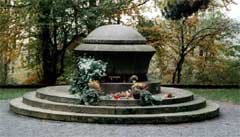
If you sit on the shore of the Happurger See, you can look across to the "Houbirg", which is a big hill, or even a proper mountain: over 600m above sea level and with most daunting looking slopes, with rocks and small cliffs (see photo). Having a good map, but not a good dictionary, I knew that there was a "late-celtic oppidum" on the top of the Houbirg, but was left wondering how the celts had managed to get an indian takeaway, and how it had kept so well. Having eaten my picnic (a ham, lettuce and tomato sandwich plus a banana, as you ask), I skipped a few stones across the lake, and went for a quick swim too. I then set off, somewhat refreshed, for the rest of my tour.
After an annoyingly short amount of time to digest lunch I came to the first hill, as the road rose up to the village of Schupf. The hill is not too steep, but relentless, straight and with little shadow at lunchtime. I was hot and out of breath at the top of the hill, and cycled straight past a memorial to the victims of the Holocaust. I couldn't work out what the Holocaust had to do with this beautiful corner of Bavaria. Maybe, I thought, a local Jewish family had been killed. If I'd taken time to stop and look, I would have seen this memorial.

The reason for the memorial is brutally simple. Towards the end of the war the Allied bombing of German towns and factories was affecting the war effort, and efforts were made to move production underground. Some bright-headed soul must have remembered the steep-sided mountain near Hersbruck, and suggested digging out the mountain to create a bomb-proof factory. A concentration camp was then built in Hersbruck to supply labour, and the Houbirg was duly dug out. Those who died were burnt in a crematorium that now lies (presumably destroyed) in the lake. When the crematoriam capacity was exceeded they took the rest of the bodies up the hill to Schupf and burnt them in the woods.
Links:
The society for the concentration camp in Hersbruck (in German). This is an excellent website describing what happened, well written, and without waffle. It is also a very good balance to the half-facts and flippancy you get on my blog.
Wikipedia page about Hersbruck.
Wikipedia page explaining what an Oppidum is.
No comments:
Post a Comment